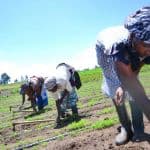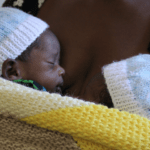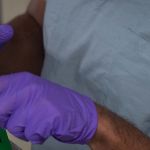Breathing Life Into Oxygen Access: How New Partnerships are Saving Lives
Every hour, 57 newborns die gasping for breath. Thousands others go on to live with brain damage. What can make a difference between life and death for these tiny lives is oxygen – something that is simultaneously all around us but a precious and rare commodity in health facilities in developing countries.
Newborns and babies have delicate lungs that easily collapse when deprived of oxygen. In fact, respiratory problems such as pneumonia, premature birth and sepsis are the leading causes of death among children younger than 5 – nearly 3 million die every year from these conditions. For these children, oxygen is the simple, yet vital, thing that keeps them alive until other medications can take effect. Administration of oxygen has the potential to prevent death in as many as 35 percent more children. It’s no wonder, then, that the World Health Organization (WHO) has listed oxygen as an essential medicine for 30 years.
Even with recognition of its importance, oxygen is seldom available and is very expensive in many countries. Roughly 25 percent of health facilities in developing countries never have oxygen available, and 32 percent have an irregular supply. On the cost side, oxygen can cost 10 to 13 times more in Africa than in the U.S. or Europe. Because of these converging factors in sub-Saharan Africa in particular, too often babies are dying in the arms of new mothers for lack of oxygen, even as nurses and doctors watch helplessly.
Partnerships can help change this status quo to ensure no child dies for lack of oxygen. They need to be inclusive, precise and immediate, however, to bring together ideas and practices from across the globe to the most vulnerable and neglected communities.
Why oxygen does not reach all
Understanding what makes a successful partnership requires returning to the root question: What causes the supply and cost issues preventing the proliferation of oxygen use in health facilities in sub-Saharan Africa? The two challenges are intertwined, and start at the source. Some countries have centralized production of oxygen, with one main oxygen plant serving the entire country. This leads to high costs in peripheral areas and a practice of using oxygen only in severe cases, because the oxygen plant and distribution points are far apart and supply often runs dry. Even health facilities that can afford the high prices are often left empty-handed.
Given that challenge of distance, the two main sources of oxygen in hospitals in low-resource settings are through concentrators and cylinders. Concentrators are the cheapest and most scalable way to supply oxygen, but most health facilities in sub-Saharan Africa lack key requirements for operating these: a reliable and clean power supply, as well as regular service and spare parts. Cylinders, on the other hand, do not require power and are easy to maintain. While they are the best and most cost-effective solution for these facilities, facilitating access to oxygen through cylinders still means overcoming challenges of steep prices and intermittent supply.
The Hewa Tele model as a solution
One promising solution is Hewa Tele (meaning “abundant air” in Swahili), an organization working in East Africa and ringing in hopes of closing the oxygen gap. Unlike other models, the Hewa Tele model is not dependent on electricity as it relies on cylinders and centralizing production while reducing distance and providing critical training and maintenance. Founded by the Center for Public Health and Development (CPHD) with support from the GE Foundation, Hewa Tele has stood out as East Africa’s first public-private partnership venture into oxygen manufacturing and supply. It successfully addresses the core concerns holding back the proliferation of oxygen usage in low-resource settings:
- Lack of local supply: The Hewa Tele approach works on the idea of setting up a large-scale oxygen plant within a public hospital to supply oxygen at affordable prices to nearby facilities; its “milkman” distribution model for last-mile delivery ensures all facilities have access to oxygen.
- High cost: The use of low-resource-setting-appropriate Pressure Swing Adsorption technology and “local centralization” have brought down prices of oxygen by up to 40 percent in Kenya.
- Lack of political will: In many instances, health administrators fail to prioritize oxygen as part of essential care. By ensuring local government and hospital stakeholders are partners in the initiative, Hewa Tele will be able to ensure it benefits the community for a long time and has also enabled high-volume public hospitals to serve more patients from lower-income categories.
- Lack of a systems solution: Without attention to protocols and guidelines for delivery, training on diagnosis and use, and accessories for delivery, oxygen need is often unmet. Hewa Tele provides critical training, maintenance and accessories necessary for health facilities to truly benefit from the availability of oxygen.
Hewa Tele was conceptualized to serve Siaya County in western Kenya and possibly a few neighboring counties, but a strong, enthusiastic response has led it to expand its coverage. Now, critically ill children at lower-level facilities are getting the oxygen they need, when they need it. In less than two years, just one plant has been able to cover a population of 3 million people over seven counties.
The call: partnerships to move the needle on access and cost
Partnerships such as Hewa Tele have made a dent in the global crisis of oxygen, but a problem of this magnitude requires a concerted effort to scale solutions around delivery, knowledge and policy to reach as many people as possible.
In 2015, CPHD and the Global Development Incubator, along with other partners, initiated a call for action at the world’s first Pneumonia Innovations Summit, where Hewa Tele was recognized as one of the top 10 innovations tackling the urgent need to make oxygen more accessible to all children. One alliance that has emerged is United for Oxygen, which is currently focused on Ethiopia, and is bringing together a consortium of government, industry, foundation and civil society organizations to scale up access to oxygen and pulse oximetry in health facilities. Meanwhile, Hewa Tele continues to partner with UNICEF, Grand Challenges Canada and Kenya’s Ministry of Health to make oxygen accessible to children in Kenya and support broader adoption of the model in the region.
To truly address the magnitude of the gap on this issue, an international effort is required to mobilize resources and create partnerships to drive practical action. A variety of stakeholders are required to develop system solutions across a multitude of settings:
- Donors can prioritize funding for improved oxygen systems and work with investors to focus their energies and resources on working with entrepreneurial solutions.
- Governments can pitch in by making regulations and guidelines that demand oxygen be available to patients as a standard of care at health centers.
- Local entrepreneurs can develop creative solutions to streamline the oxygen supply chain – whether at distribution, training, maintenance or somewhere in between.
- Leading health bodies such as the WHO and UNICEF can help by demanding quality when it comes to oxygen care.
In the time it took you to read this article, six babies would have died from respiratory problems. It’s time we make oxygen a front-and-center priority, and use the tools at our disposal to make sure this seemingly “invisible” essential drug is readily available in developing countries, too, so that no child dies for lack of oxygen.
Dr. Bernard Olayo is founder and chairman of the Center for Public Health and Development and Moitreyee Sinha is director of the Beyond Health portfolio at the Global Development Incubator.
Photos courtesy of Hewa Tele
- Categories
- Health Care



